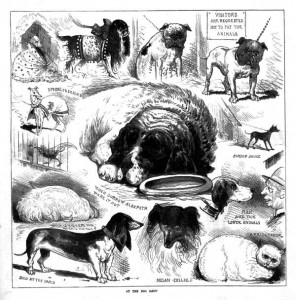In the 1840s and 50s, Melbourne had an unregistered dog problem. Initially the stray dogs were only a nuisance, but they soon became aggressive and threatened the safety of Melburnians.
‘The early 1840s saw many ferocious dogs at large in the settlement, by day in packs of up to a dozen attacking the defenseless or inebriate, by night waking the town with their yelping’ (1).
To try and control the problem police were paid 2s 6d for each unregistered dog they killed. By 1848, with the problem still out of control, citizens were also deemed eligible to receive the reward. However, by the 1850s Melbourne was still full of unregistered dogs (ibid).
The Argus of October 1855 reported that ‘all persons are authorised, and constables are particularly enjoined, to kill all dogs found at large without collars…Every person who shall possess the tail of a dog which he has destroyed…shall receive 2s 6d.’
In a further effort to curb dog numbers, in 1855 the New South Wales Government extended its Dog Nuisance Act, (p. 2392), to include ‘the City of Melbourne.’ This meant that all dogs in the town would have to be registered.

But the reward for killing created a new problem: what to do with the rotting carcasses. It was reported that constables were throwing them into rivers (2). One solution, offered in 1882, was to use the destroyed dogs to fertilise the shrubberies at the MCG (1).
The first act of the Victorian parliament dealing with dog registration was the Dog Act 1864, with the penalty for non-registration a fine of ‘not less than five shillings and not more than ten shillings.’ Every dog from then on had to wear a collar which stated ‘Registered at…’
At the dog show, A/S21/09/85/145
1. Brown-May, Andrew 1998, Melbourne street life: the itinerary of our days, Australian Scholarly Publishing, Kew, Vic.
2. Cannon, Michael 1991, Old Melbourne town before the gold rush, Loch Haven Books, Main Ridge, Vic.
Written by Paul Dee,
Librarian, Australian History and Literature Team


